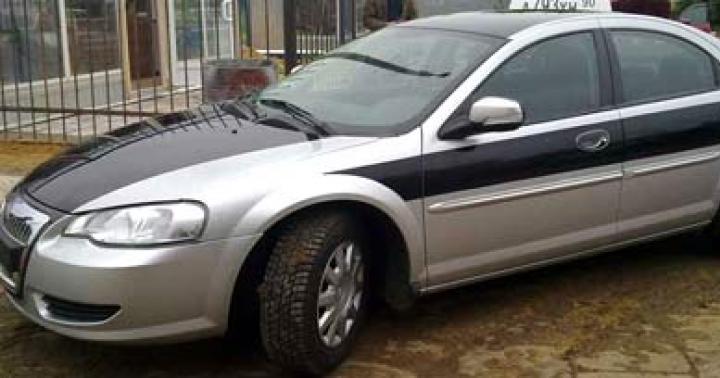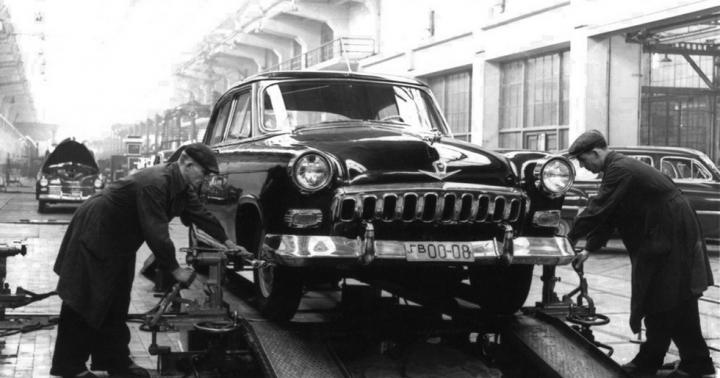In the process of choosing to purchase a used car, the main indicators affecting the cost will be the year of manufacture, the number of owners, technical condition and mileage. It is possible to establish all owners and the date of issue according to the documents, but the indicators of the traveled mileage may reflect false data. Thanks to "specialists" and modern technology, the procedure for changing the mileage indicator has become uncomplicated, which makes it possible to unreasonably overestimate the cost of not new vehicle.
How does the mileage curl?
The number of kilometers traveled during the vehicle's operational life has a direct impact on its technical condition. To falsify this indicator, the odometer data is changed in the following ways:
- In a mechanical device, the numbers are flipped manually, for which it is enough just to disassemble the dashboard. Also, with the help of a drill, the speedometer cable connected to the transmission gearbox is unwound in the opposite direction.
- In the electronic odometer, the readings in the on-board computer memory chip change. To do this, they find out which of the boards stores the information on the readings of the instruments, and, using special devices with the appropriate software, record the required value.
Methods for determining the real mileage of a car
Initially, the mileage and technical condition of a used car is found out when talking with the seller, specifying when it was carried out Maintenance, replacement of parts and operating fluids... With a weak competence in these matters, it is advisable to take a specialist with you. If the owner's words have raised doubts or there is a desire to confirm the information given by him, you can resort to the following methods of determining the real mileage:
- According to information received from authorized dealer.
- With the help of special services or after a complete diagnosis.
- According to the condition of the materials in the vehicle interior.
- According to the technical condition of individual units and parts of the car.
Determination of mileage based on the state of the passenger compartment
Assessment of the condition of interior parts can confirm the technical condition and real run vehicle only indirectly. All materials have a certain resource of production, in which, after a corresponding period of operation, they are in a naturally worn out state, by which it is possible to approximately determine the mileage, and also notice the discrepancy between the degree of wear and the declared mileage. 

Determination of mileage based on the technical condition of the car
According to statistics, on average a car covers 25-30 thousand km per year. If the seller of a used car is trying to convince that a seven-year-old car has covered 90 thousand km, then it is highly likely that this is a hoax. The assumptions can be confirmed by the signs of the technical condition of the vehicle:
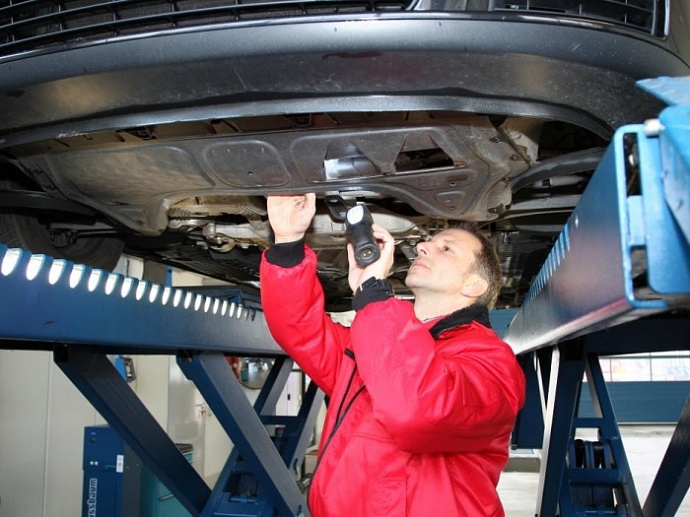
How to check if the mileage is twisted using special services
When buying a used, but expensive car, in order to obtain comprehensive information about its technical condition and real mileage, a full diagnosis should be carried out at a service station. The procedure is not cheap, but it will give full confidence that it is not a "pig in a poke" that has been purchased, but a serviceable car with real mileage. Checking cars by VIN code full guarantees of truthful information will not be given; service services will also be required to confirm it.

Checking a car purchased from an authorized dealer, or referring to the database of a specific automaker, will provide broader and more accurate information. It is worth considering that in modern cars mileage indicators are duplicated, and a cheap correction often cannot hide real indicators, which are determined by special equipment at the service station of official car dealers. If you find any, even a small difference between the real and twisted mileage, you should refuse to buy a car.
23.03.2015
When buying a car for secondary market you can never be completely sure about the honesty of the odometer reading. What is the reason for this? - It's simple. Today there are more and more people who want to twist the mileage of a car and pass off a very "worn-out" car for an almost new vehicle. Experienced dealers skillfully sell cars that have traveled more than 300-400 thousand kilometers, with more modest odometer readings. Naturally, the cost of the car also increases by 30-40%. This is a great business.
Most resellers only make money on this. They buy an old (but demanded car in the market) car on the cheap, put it in order at the service station, twist the speedometer and sell it. The price difference can be quite significant. The worst thing is that with the advent of electronic odometers, the problem has not disappeared in any way - malicious manipulations with the readings of the device remain in force.
How it's done?
- Mechanical odometers are a "classic". Here any auto mechanic can make "adjustments" to the mileage indicators. How? - It's very simple. The speedometer cable is thrown away from the vehicle's gearbox. After that, with the help of a drill well known to us and a large drill, it is rewound in the opposite direction. After that, the cable is put in place.
Voila! After the simplest manipulations, the car becomes "newer". It is very difficult to recognize such a deception. The only thing that can be done is to get under the car and carefully study the features of the cable attachment. But even here there is no guarantee that you will be able to notice the alteration.
The fraudster can only be “betrayed” by the amazing cleanliness of the fastening nut. It will immediately catch your eye if everything else around is covered in dust and dirt.
- The electromechanical type odometer also twists without much problem. All that is needed is to remove the dashboard, get to the odometer case and "wind up" the readings of interest. The only thing that will have to be done for this is to disconnect the counter gears for a while. Such an intervention will not reveal any problems - traces will definitely remain on the fixing nuts.
- Electronic odometers are not as reliable as we would like - they can also be hacked and twisted. But how? To complete the work, the wizard needs the appropriate software, a laptop and a connector for connecting to the ECU. Sometimes it may be necessary to disassemble boards, dashboards and even interfere with conductive elements. Such a change in mileage can also be easily detected by opened seals or by checking through a PC (if a specialist is at hand).
How can you tell if the counter is twisted?
If a professional was involved in twisting the odometer, then it is very difficult to identify the interference. Of course, you can inspect the dashboard, the integrity of the screws, and even look under the car. But if desired, all manipulations can be hidden and veiled as much as possible. But don't be discouraged. Twisted mileage is easy to diagnose with a number of external signs. Imagine for a second that you are Sherlock Holmes and your task is to conduct a small investigation into the history of the car. During your research, pay attention to the following points:
- Condition of the gas, brake and clutch pedals. Nothing gives out a worn-out car like the pedals of the car literally worn out to the "holes". For example, the seller claims that the car has covered no more than 50-60 thousand kilometers (the same information is given by the odometer). You're looking at pedals that are literally polished to shine with the shoes of a past driver. The mileage of a car with such "symptoms" can probably reach 100-150 thousand kilometers. Of course, this method can hardly be called ideal, because the pedals could be replaced during operation.
If new rubber bands are installed on the levers, then this should not cause joy, but suspicion. There is a high probability that the seller is hiding the real age of the car;
- Take a look into the "driver's tunnel", which can tell a lot about the age of the car. Generally, this place is considered one of the dirtiest in the car. Even car washers rarely get there when cleaning the interior. What can we say about the attempts of the motorist himself. Constant friction with the shoe, the action of reagents from the road and other negative factors do their job. It is expensive and pointless to completely lay a new coating.
On the other hand, you can do a general cleaning of the salon and literally "lick" this place to shine. But it is precisely this diligence that should alert you, as well as obvious abrasions, cracks and other panel defects. Agree, for 40-50 thousand kilometers it is very difficult to significantly wear out the "driver's tunnel". In the case of a more serious mileage (about 150-200 thousand kilometers), there are no problems;
- You can make it even easier without even bending over. Carefully inspect the condition of the steering wheel. It is best if it is covered with leather, because in this case it is most difficult for the past owner to "fake" the age of the car. Firstly, it is difficult (even more impossible) to restore the skin. Secondly, full hauling steering wheel is an expensive pleasure (if a regular cover is installed, it is enough to remove it). The worn buttons on the steering wheel can tell a lot.
- Inspect the condition of the seat upholstery. The level of wear should match what you see on the steering wheel of your car. If the seats are clearly "squeezed", and wheel new, then this can make it possible to catch the seller of a lie and promptly refuse to buy.
It is important to remember that no tissue is able to remain in a normal state after 100-150 thousand kilometers. In any case, it will burn out and seriously wear out. As for dry cleaning, it can only remove stains, but not restore the original appearance of the product.
In addition, the seats, as a rule, are cleaned from above, but rarely anyone looks underneath. This is what you can take advantage of. Lift the chair up and check the quality of the fabric in color and texture. If there are obvious differences, then it is not at all difficult to draw a corresponding conclusion. The situation is similar with leather goods. Of course, they will not wear off after 100-150 thousand kilometers, but most of the varnish or paint will certainly slip. Pay attention to whether the seat was stitched - this is immediately noticeable;
- Front panels are often made of plastic. But this is an excellent indicator of age. Buttons and handles with printed images are overwritten from long-term use. The more wear and tear, the older car... Of course, there are no explicit criteria here. But you must agree, if you are offered a car with supposedly 40-50 thousand kilometers, and the images on the buttons are already completely worn out, then the deception is obvious;
- The gear knob, ignition lock and handbrake are important assistants in the diagnosis of deception. The more they are worn out, the older the car is. If all the parts of the interior are new, then this is not a well-groomed car, but an ordinary "constructor", which was assembled literally in parts;
- The capabilities of an authorized dealer should not be underestimated. If the car was bought in Russia, then information about it was necessarily saved in the database. You can find out all the data about maintenance, what work was carried out, what was the mileage, and so on. In the end, the end can be made to diagnose the car and identify its real condition.
Output
Do not be afraid to be picky when buying a car, because we are talking about a very large amount. Agree, it is not very pleasant to buy a car with a mileage of 50-60 thousand kilometers, and then discover its real age. And this fact will emerge sooner or later. Once in the car, everything will start to "crumble", and you will find yourself at the service station, where good masters will open their eyes to the bitter truth. Be careful. Good luck.
How to check if the mileage on the car odometer is twisted? What are the ways for this? How do the odometer readings twist? You will find answers to these and many other questions in this article.
How to determine twisted mileage on the odometer
When buying a used car, most motorists consider the mileage of the car as one of the key indicators of the technical condition of the vehicle. However, even the most modern odometers can be prone to twisting readings, and the mileage displayed on them can be significantly underestimated or overestimated.
In this regard, the question of determining the real mileage of a car worries all buyers of used cars. This article will provide general information about the methods of such shenanigans, as well as how to determine the twisted mileage on the odometer.
How the odometer rolls up
There are three main types of odometers found in cars today:
Mechanical;
Electromechanical;
Electronic.
Video: How to Determine Twisted Mileage on the Odometer?
The most unprotected from manipulation are the older, mechanical car mileage meters. To twist their readings, it is enough to disconnect the speedometer cable from the gearbox and "rewind" several tens of thousands of kilometers using a power tool (for example, a drill). Also, sometimes the instrument panel is simply opened and the necessary indicators are manually set.
Electromechanical devices are also opened. Dropping is carried out due to the disconnection of the gears of the counting mechanism and setting the mileage.
Electronic odometers are the most modern today and are constantly being improved. To roll up the mileage on these meters, the most common are two ways:
Making adjustments to the on-board computer software;
Replacing the memory block, including individual microcircuits designed to store information about the mileage.
Video: How can you find out the honest mileage using a car computer?
Thus, as already mentioned, almost all systems for calculating the distance traveled by a car cannot provide guaranteed data reliability.
Methods for determining twisted mileage
After tampering with the car's odometer, it is almost impossible to find out the exact actual mileage, and with a successful combination of circumstances, the buyer can only determine the fact that the displayed data is unreliable. All methods for determining the twisted mileage on the odometer can be divided into two types: direct and indirect.
Direct signs
Signs that directly indicate false odometer readings include various additional documentation for the car or alternative data stores.
Service documents
First of all, it is necessary to check the service book of the vehicle, since when performing scheduled maintenance or even just an oil change, the master should indicate the current mileage.
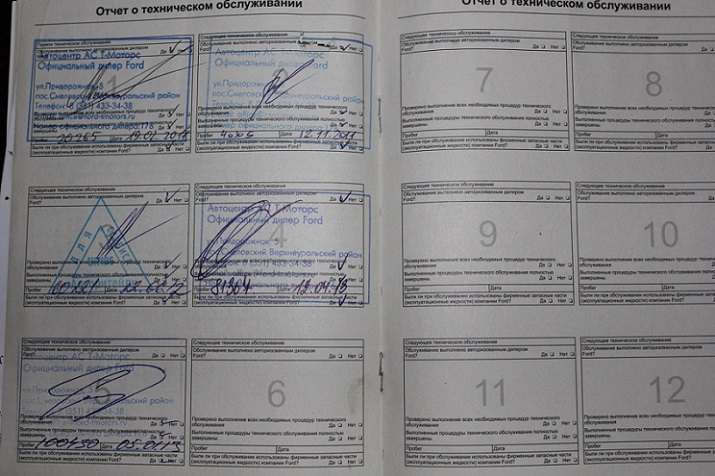
Also, many companies use special stickers about the oil change carried out. They also indicate the odometer readings at the time of work. As a rule, they are glued to the inside of the bonnet, but they can also be found anywhere in the cabin.
Important! Absence service book and stickers should also alert the buyer.
Auction documents
If the car was imported from the USA or Japan, then it is highly likely that it was bought through an auction. In these countries, there are electronic databases that display all information about the cars sold through the auction, including their mileage at the time of sale.
Access to the American bases can be easily obtained via the Internet. So, in the United States, Autocheck and Carfax services operate and to receive information in them, it is enough to enter VIN of the car(recorded in the passport for the vehicle).

In the case of Japanese cars, an auction sheet is attached to the documents on the car, which also displays information about the car at the time of sale.
On-board computer backup memory
Another source of the real mileage of the car can be the backup memory of the on-board computer. Modern cars are equipped with such elements specifically to protect the genuine information about the machine. So, for example, in modern BMW models one of the backups is placed even in the auto key.
It is very difficult to make changes or write the necessary information to the backup memory blocks, but, unfortunately, today they are found only on practically new machines of the premium segment.
To obtain information from backup storages, it is enough to contact a professional. It will connect to on-board computer and will find information.
Indirect signs:
Signs that do not directly indicate twisted odometer readings, but allow us to make such a conclusion, include the technical condition and deterioration of certain parts.
Important! Draw conclusions about the unreliability of the displayed mileage, only on one of the indirect signs it is forbidden.
Very often you can hear that if the gear shift knob, steering wheel, buttons on the panel or pedals are too worn out, the driver's seat is squeezed, then these are signs of a large car mileage.
However, in this case, the subjective factor also plays an important role. For example, one of the drivers could have a fairly large weight, another could use a steering wheel cover, and a third, working in a service station, often gets behind the wheel with dirty hands.
2) Brake and steering systems
One of the most reliable indirect signs indicating a high mileage of a car is a worn out brake disc. It is very simple to check this: it is enough to visually inspect it with a well-washed wheel - there is nothing to hide the tracks from the brake pads.
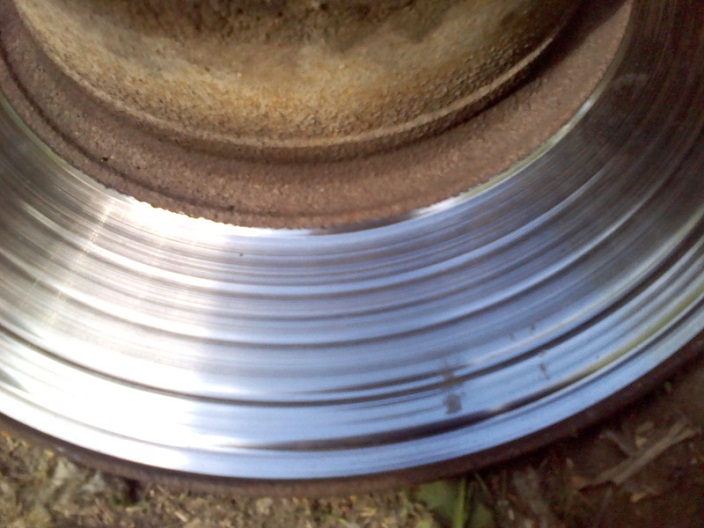
It is also worth inspecting the tie rod ends. These parts can be further evidence of a high mileage, but a lift will already be required to inspect them.
Important! If a car with no high mileage installed, for example, new brake discs, then this is also an indirect sign of high mileage.
Specialized inspection at the service station
Experienced craftsmen and professional equipment are another way to identify twisted mileage on the odometer. The pressure in the oil system and cylinders, the condition of the exhaust are the most basic characteristics that will allow experts to deliver their verdict.
Important! The buyer must choose the service station where the inspection will be carried out. Otherwise, there is a high likelihood of a forgery of the master by the seller.
Instead of output
As already mentioned, if an experienced professional carried out the fraud of twisting the run on the odometer, then it will be extremely difficult to detect it. Moreover, the older the car, the less secure the mileage calculation system is, and the more difficult it is to identify indirect signs.
If you are planning to purchase relatively new car(which most likely costs a significant amount), it is better to slightly increase the search time, but to buy a car, the technical condition of which (including mileage) will not raise doubts.
The key to a successful purchase of a used car is a correct assessment of its technical condition. The mileage of a car is one of the indicators of its wear. With a high mileage, the car may need to be repaired within a month.
Mileage data is displayed on the odometer. But, turning to specialists, you can rewind it for any mileage. If the numbers on the analog odometer are not symmetrical, then the device has been curled up. Pay attention to the degree of wear on the steering wheel, glasses, wear dashboard, seats. Close and open the doors, check for any looseness or slack in the hinges. If the cabin is in a deplorable state, then the figure on the odometer of 45,000 km is false. Keep in mind that the steering wheel could be fitted again, the elephant could be cleaned, and covers could be put on the seats.

![]()
mileage-over-140-000-km
Inspect the front of the radiator. If the car has traveled more than 90,000 km, then it will have a lot of minor damage from sand and gravel.

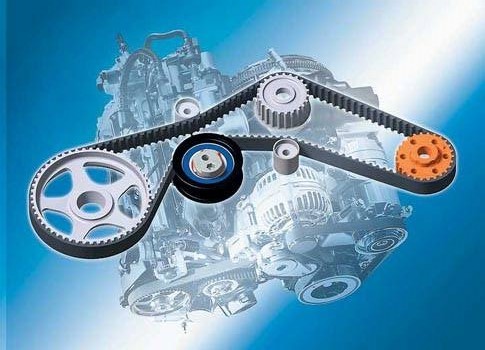


Consider: vehicle mileage does not always determine vehicle wear. If the previous owner took care of the car, changed the oil, worn out parts on time, then his car will be in good condition even after 250,000 km.
In our company, they are interested in whether we can accurately determine whether the readings on the speedometer correspond to the actual mileage of the car?
As a detailed answer to this question, I decided to write this small note.
In short, there is only one way to 100% confirm the mileage of the car: the car has a service book with marks about all MOTs - from the first to the last. Then you can contact the dealer whose car was serviced and get confirmation that the service book is real, and all the MOTs indicated there were really carried out with them. If the service book with all the marks is not attached to the car, the mileage of the car is a virtual concept, and can be absolutely anything.
The rolling service in Moscow now costs from 1,500 to 15,000 rubles, depending on the model and the complexity of the work being done. Modern technical means allow you to completely change the information about the mileage, both in the main and in the duplicate blocks. All the ingenious gadgets invented by manufacturers in order not to allow the mileage to be twisted are dispensed with by experienced electronics technicians.
Selection of a used car - how is the process going?
When we select a car, the options without a service book are examined by the master and for compliance with the real mileage with the one on the speedometer. That is, indirect signs are carefully studied to identify inconsistencies. The state of a number of interior elements looks for scuffs. For example, scuffs on the steering wheel are formed when the mileage exceeds 100,000 km. Therefore, if the steering wheel is worn, and on the speedometer - 60,000 - the mileage was clearly twisted.
Also, when we select a car, we carefully study the degree of wear of some suspension elements and drive belts... For example, we know that according to the manufacturer's regulations for this model, the brake discs must be replaced every 100,000 km. On examination, it turns out that the disks are almost completely erased and should be replaced yesterday. At the same time, the speedometer shows 50,000 km. The discrepancy is obvious.
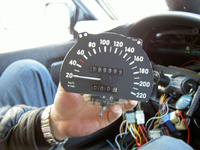 You have to understand that there can be no 100% guarantee here. If there is no service book, the mileage of the car can be confirmed, or not confirmed by a number of indirect signs - only with a certain degree of probability! Which, nevertheless, is quite large, but still less than 100%.
You have to understand that there can be no 100% guarantee here. If there is no service book, the mileage of the car can be confirmed, or not confirmed by a number of indirect signs - only with a certain degree of probability! Which, nevertheless, is quite large, but still less than 100%.
It turns out that the indicator on the speedometer in Russian conditions is not a reliable indicator, and it should not be taken into account in the first place when buying a particular car. What is more important? More important is the condition of the body and the technical condition of the car. Modern foreign cars have a huge resource - the engines of most models do not require a bulkhead up to 500,000 kilometers. If the machine is regularly serviced, and the parts that fail are changed in a timely manner, it can serve for many years, and travel 200 and 300 thousand kilometers during this time.
But since we provide assistance in the selection only for those who want to buy a car no older than 7 years old, the horizon of the runs of those cars with which we are dealing does not exceed 150,000 km (this is when it comes to 7-year-olds).
From my point of view - there is no fundamental difference between the mileage of 80,000 and 100,000 kilometers - for good car both are insignificant. If the diagnostics of a certain option shows that the car does not require investments, and the body has not been in serious accidents - all other things being equal, I would give preference to a car with high mileage, but in best condition interior and with fewer traces of use than a car with less mileage, but less accurately operated.
However, the taste and color - all markers are different. We proceed from the interests of the customer. If the customer's wish is to limit the mileage of the selected car to some small (for a given year of manufacture) value, and the options offered on the market allow choosing such a car - I will not insist on my point of view - we will search as you say!

